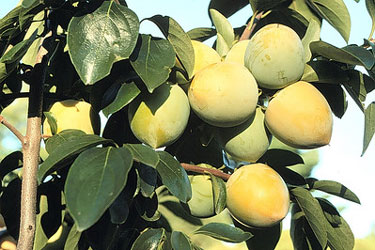Japanese Persimmon
 Searcy, Ark. – Arkansans are no strangers to persimmons, but kaki, (the Japanese name
for the fruit) is something else.
Searcy, Ark. – Arkansans are no strangers to persimmons, but kaki, (the Japanese name
for the fruit) is something else.
Persimmon trees are small, easy to grow, and adapted to Arkansas. The tree, its leaves, and its fruit don’t have to be sprayed because they have no serious insect or disease problems.
In the fall, when few fruit crops are ripe, the persimmon produces fruit that is attractive and delicious. Persimmons are rich in vitamin A and have more vitamin C than citrus fruit. They are considered a delicacy in the Orient. The wood, which is very hard, is prized by woodworkers and is used to make golf clubs. Mature trees can reach 40 feet high; some remain as shrubs less than 10 feet tall.
Oriental persimmon, Diospyrus kaki, (pictured above) was introduced into the United States in the mid-1800s from its native China and Japan. It has been an important fruit crop in each of those countries for hundreds of years. The fruit is eaten fresh, dried, or cooked. In northern China, some valleys grow only Oriental persimmons. On the main island of Japan, persimmon trees are found in every village, along the roadsides, and around farmers’ cottages.
What persimmon varieties are native to North America?
There are around 500 species of Diospyros described throughout the world, though only two are native to North America. Two additional species are native in Hawaii. The dense black wood known as ebony is D. ebenum, a native of Ceylon.
Our native persimmon and the Oriental persimmon are the two outliers of the Diospyros, for most are tropical or subtropical trees and shrubs. “Fuyu” is a Japanese clone and is described as mop-headed (mounded) trees seldom over 20 feet tall. Some Chinese clones such as “Great Wall” are erect growing and may be taller.
Kaki leaves are lanceolate, glossy green and four to five inches long with a short petiole and an entire margin. The leaves are blemish free during the growing season and turn yellow to orange in the fall. The leafspot disease that often renders our native persimmon unsightly by fall, does not afflict its Asian cousin.
Oriental persimmon flowers appear after the leaves emerge in the spring and mostly go unnoticed. Plants are dioecious with male or female trees, though some clones will produce both male and female flowers on the same plant. Female flowers are slightly fragrant, borne singly with four whitish to pinkish petals that are about half an inch long. “Fuyu” is parthenocarpic and sets fruit without need for pollination.
Oriental persimmon fruit vary considerably according to the selection, though yellow-orange, tomato shaped fruit to three inches across are representative. “Fuyu,” a popular Japanese clone with non-astringent flesh, is seedless and can be eaten in its firm state like an apple or allowed to ripen to soft, mushy texture.
Does the Japanese persimmon do well in Arkansas?
The Japanese persimmon is hardy throughout Arkansas though it is more reliable as a fruit tree in the southern half of the state. It should be given full sun and a rich, moist site. It can be used in mixed borders, as a small specimen in the vegetable garden or even grown in a large container.
Characteristics of Oriental Persimmon Varieties
Most Oriental persimmons, except ‘Eureka’, produce seedless fruit. Seedless fruit tends to have better eye appeal, and often have darker flesh.
‘Eureka’ is heavy producing, medium- sized, flat-shaped, red persimmon of extremely high fruit quality. The tree is relatively small and self-fruitful. Fruit typically contain seeds. ‘Eureka’ has proven to be the best commercial variety.
‘Hachiya’ is a productive, very large, cone- shaped, seedless persimmon with bright orange skin. The tree is vigorous and upright. ‘Hachiya’ has been an outstanding Texas variety and makes an excellent dual-purpose fruit and ornamental specimen.
‘Tane-nashi’ is a moderately productive, cone-shaped, orange persimmon. The tree is vigorous and upright. The fruit stores extremely well on the tree and is seedless. ‘Tane-nashi’ makes an excellent landscape ornamental.
‘Tamopan’ is a moderately productive, very large, flat, orange, persimmon with a distinctive ring constriction near the middle of the fruit. The tree is the most vigorous and upright of the varieties
‘Fuyu’ is a medium-sized, non-astringent, self-fruitful persimmon. The fruit is rather flattened, orange-colored, and of high quality. It is best planted in the southern, milder areas of the state as it is susceptible to freeze damage.
‘Izu’ bears medium-sized, non-astringent fruit. It seems to be more cold-hardy than ‘Fuyu ‘and ripens in September.
‘Fankio’ produces large, conical, with vivid gold fruit. It is one of the prettiest persimmons; the leaves turn bright red as the gold fruit ripens in the fall.
Read more about persimmons on our Plant of the Week article!
The University of Arkansas System, Division of Agriculture is an equal opportunity institution. For more information you can contact your local county extension service, you can also follow Sherri Sanders on Facebook @UAEX.WhiteCountyAgriculture .
###
By Sherri Sanders
White County Extension Agent - Agriculture
The Cooperative Extension Service
U of A System Division of Agriculture
2400 Old Searcy Landing Road Searcy AR 72143
(501) 268-5394
ssanders@uada.edu